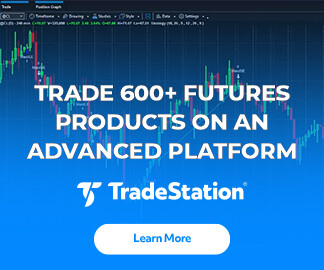Investors face many potential risks in the stock market. Today we’ll focus on the important issue of sector risk.
Sectors are broad categories of companies like technology, health care and financials. Because their businesses are often similar, companies in the same sector can move together or impact each other. There are even times when the market could ignore news for an individual company because of something happening at the broader sector level. This makes it crucial to understand how your portfolio is exposed to various sectors.
Identifying Sector Risk

Fortunately, TradeStation’s award-winning tools makes it easy to identify sector risk in your holdings or any list of stocks. Traders can begin by opening RadarScreen by going to the Apps bar at the top left of their desktop platform and clicking on the RadarScreen logo.
- Next, enter a list of stocks into the Symbol column along the left.
- Then click on Studies → Add Study. A dialog box with two scrollable windows will appear.
- Scroll down the left window and select “Industry.” Click on the “Add->” button.
- Scroll down further and select “Sector.” Click on the “Add->” button.
- Close the dialog by selecting “OK”.
This will display new columns with industry and sector for each stock on the list. You can sort by clicking on the column headers.
Sectors vs. Industries
While the terms are often used interchangeably, “sector” and “industry” have different meanings. Sectors are broader groupings like technology, while industries are narrower categories like software or semiconductors. Some industries are further divided into subindustries.
S&P Global (SPGI), which runs major indexes like the S&P 500, currently recognizes 11 sectors. Below we’ll review key points about each.
Economic sensitivity, or “cyclicality,” is another important consideration. Some sectors are economically sensitive. That means they benefit from an improving economic cycle. Others are non-cyclical because their businesses don’t fluctuate as much with the economy.
Technology Sector
Technology is currently the largest sector by market capitalization. It includes major names like Apple (AAPL) and Microsoft (MSFT), the two biggest U.S. companies by market capitalization as of June 17, 2022. The technology sector’s top industry is software, followed by semiconductors.
Technology stocks are somewhat cyclical because demand for electronics fluctuates with the business cycle. However many software companies are “growth stocks,” which means they might struggle with interest rates rise.
The SPDR Select Technology ETF (XLK) tracks technology stocks. The sector is also closely associated with the Nasdaq-100 index, where most of the large stocks trade. Several companies associated with technology, like Amazon.com (AMZN) and Alphabet (GOOGL), are actually in the next two sectors.
Consumer Discretionary Sector
Consumer discretionary stocks mostly sell items that aren’t basic necessities, or can be deferred during recessions. They include clothing, automobiles and houses (unlike food or toothpaste). Consumer discretionaries are cyclicals because they tend to do better when the economy is improving, or investors expect an upturn.
Amazon.com (AMZN) and Tesla (TSLA) are currently the biggest consumer-discretionary stocks.
The SPDR Select Consumer Discretionary ETF (XLY) tracks consumer discretionary stocks.
Communication Services
Communication services are the newest sector, having been established in 2018. This group is includes Internet companies, traditional media and telecoms. For the most part, communications rely on advertising. Alphabet (GOOGL) and Meta (META) are currently the largest communications stocks.
The SPDR Communications ETF (XLC) tracks communications stocks.
Financial Sector
Financial stocks include banks, Wall Street securities firms, asset managers and insurance companies. Most financials are highly cyclical because a stronger economy drives demand for their services. It also reduces the number of borrowers missing debt payments.
The current environment offers potential challenges to the sector because short-term interest rates have risen more quickly than longer-term rates. This so-called flattening of the yield curve can make it harder for banks to make money.
The SPDR Financial ETF (XLF) tracks financial stocks. Berkshire Hathaway (BRK.B) and JPMorgan Chase (JPM) are currently the biggest financials.
Health Care
Health care stocks are non-cyclicals because demand for their services is mostly unrelated to the economy. The sector includes major pharmaceutical makers like Johnson & Johnson (JNJ) and health insurers like UnitedHealth (UNH). Medical devices, biotechnology and hospitals are other industries.
The SPDR Health Care ETF (XLV) tracks health care stocks.
Industrials
The industrial sector is a diverse set of companies including machinery, transportation and business services. Industrials are highly cyclical because they generally benefit from a stronger economy. The main exception is defense contractors like Lockheed Martin (LMT) and Raytheon (RTX), whose businesses are more tied to government spending.
The SPDR Industrial ETF (XLI) tracks industrial stocks.
Consumer Staples
Consumer-staple companies sell basic essentials for everyday living, like food and cleaning supplies. These products are non-cyclical because demand doesn’t increase significantly during periods of economic growth. (People might eat out more, but restaurants are discretionaries.)
Investors often favor staples during periods of economic weakness. They may lag the broader market when investors expect an economic upturn.
The SPDR Consumer Staples ETF (XLP) tracks consumer staples. Walmart (WMT) and Procter & Gamble (PG) are currently the biggest members of the sector.
Energy and Materials
The energy sector and materials sector are smaller sectors with significant exposure to the economic cycle.
Energy stocks have outperformed in 2022 as the global economy recovers from the coronavirus pandemic. They’ve also benefited from sanctions on Russia, one of the world’s top exporters of oil and natural gas. The energy sector includes pure-play producers like Occidental Petroleum (OXY). It also has refiners like Marathon Petroleum (MPC) and servicers like Halliburton (HAL). Exxon Mobil (XOM) and Chevron (CVX), currently the biggest energy companies, are “integrated” because they produce, refine and sell energy products.
The SPDR Consumer Energy ETF (XLE) tracks energy stocks.
Materials stocks include chemical companies, metal producers and packaging. The SPDR Materials ETF (XLB) tracks materials stocks.
Utilities and Real Estate
Utilities stocks are one of the most stable and non-cyclical sectors. Their revenues and profits tend to be highly predictable, letting them pay steady dividends over time. Investors often view utilities as safe havens. They’re seldom popular with traders.
The SPDR Utility ETF (XLU) tracks utility stocks.
Real estate is a more diverse set of companies with physical properties. Shopping centers, apartments and office buildings are their traditional assets. However the real estate sector now includes owners of wireless towers, e-commerce warehouses and cloud-computing data centers.
Companies in this sector are also structured as real-estate investment trusts (REITs), which gives them special tax treatment. (That’s why homebuilders aren’t included.)
The SPDR Utility ETF (XLRE) tracks real-estate stocks. American Tower (AMT) and Prologis (PLD) are currently the biggest real-estate companies.
Managing Sector Risk
Large institutional investors often take a top-down approach, concluding that certain businesses are likely to do better than others in coming months. For example, they dumped energy stocks in early 2020 as demand dried up and rotated into e-commerce stocks that benefited from social distancing. Just the opposite has happened in the last year as oil prices and interest rates rose.
Sectors are the main categories portfolio managers and strategists use to assess the market and allocate capital. This can present challenges and opportunities for retail investors. It can be difficult because financial results of individual companies often matter less than sentiment toward the broader group. They can potentially overcome these challenges by watching the performance of individual sectors and avoiding companies in weaker parts of the market.
Visit www.TradeStation.com/Awards to learn more.
Exchange Traded Funds (“ETFs”) are subject to management fees and other expenses. Before making investment decisions, investors should carefully read information found in the prospectus or summary prospectus, if available, including investment objectives, risks, charges, and expenses. Click here to find the prospectus.
Performance data shown reflects past performance and is no guarantee of future performance. The information provided is not meant to predict or project the performance of a specific investment or investment strategy and current performance may be lower or higher than the performance data shown. Accordingly, this information should not be relied upon when making an investment decision.

























